What is now the state of Nevada was home to American Indian people for several millennia prior to the arrival of the first Europeans in the area. As a part of the Great Basin, Nevada is often seen as being somewhat inhospitable to human habitation. The Great Basin Area includes the high desert regions between the Sierra Nevada and the Rocky Mountains. It is bounded on the north by the Columbia Plateau and on the south by the Colorado Plateau. It includes southern Oregon and Idaho, a small portion of southwestern Montana, western Wyoming, eastern California, all of Nevada and Utah, a portion of northern Arizona, and most of western Colorado. This is an area which is characterized by low rainfall and extremes of temperature. The valleys in the area are 3,000 to 6,000 feet in altitude and are separated by mountain ranges running north and south that are 8,000 to 12,000 feet in elevation. The rivers in this region do not flow into the ocean, but simply disappear into the sand. The summers are hot and the winters are cold. Yet in spite of the ecological challenges, Indian people successfully adapted to the region.

Living in the Great Basin required that Indian people have an intimate knowledge of a fairly large territory. During the subsistence cycle, which was often a one to three year cycle, small bands of Indians would exploit the resources-animals, plants, and rocks-over a territory of several hundred square miles that would include several different biomes or ecologic communities.
The archaeological data from Nevada is rather scarce and thus we don’t have a full picture of ancient life in the Great Basin. The archaeological record includes rock art sites with pictograph and petroglyph panels, rockshelters, chipping sites where stone tools were produced, hunting blinds, and open campsites. What follows are the highlights of what we do know from the retreat of the ice fields about 12,000 years ago until the introduction of the bow and arrow about 2,500 years ago.
Stone Tools and Subsistence Patterns:
Much of the data from the earliest sites in the Great Basin is about stone tools and subsistence patterns. Archaeologists often name early cultures after stone tool styles, such as Clovis, Folsom, Scottsbluff, Elko, Desert Side Notched, Gypsum Cave, Hell Gap, and so on. The data from these early sites often provides information about the plants and animals which the people used for subsistence.
By 10,800 BCE, Indian people were occupying the Bonneville Estates Rockshelter. The shelter was used as a short-term camp. They were using nets of juniper-bark cordage to trap small game, such as rabbits and grouse. Their diet included big game (bighorn sheep, pronghorn antelope, mule deer), small game (rabbit, grouse), and insects (grasshoppers).
Indian people were living in the Black Rock Desert in northwestern Nevada by 10,000 BCE. They were making a kind of projectile point which archaeologists will later call “Great Basin Stemmed”.
By 9245 BCE, Indian people at the Falcon Hill site were using Catlow Twined Basketry. This is a semiflexible basket made from twisted tules.
The Western Stemmed Tradition developed in the Great Basin about 9100 BCE spread east. The points were halfted on a socketed shaft.
The period which archaeologists call Wendover began in Utah and Nevada about 7500 BCE. At this time Indian people were engaged in a roving pattern of hunting and gathering. They were occupying settlements seasonally. Plant foods included seeds from pickleweed as well as other plants. The big game animals hunted at this time included deer, pronghorn antelope, mountain sheep, elk, and buffalo. Small game, such as rabbit, were trapped with netting.
In 7000 BCE, Indian people at the Komodo Site were using spear points which archaeologists classify as Great Basin Concave.
By 6900 BCE, the western Great Basin had become more arid. This caused the Uto-Aztecan-speaking hunting and gathering bands to begin a migration to the west and south. This was the initial breakup of this language family into what would become more than 30 distinct languages.
In 6700 BCE, Indian people began to use the Leonard Rockshelter.
In 6600 BCE, a string of about 50 large spire-ground Olivella biplicata beads were obtained in trade from the Central California coast and carried some 250 miles to Nevada. The presence of a complete string of olivella beads some 250 miles from their source provides evidence of an extensive intertribal trading system.
In 6030 BCE, Indian people left a cache containing an atlatl (spear thrower) at a site in western Nevada. Made from an unidentified hardwood, the upper surface of the atlatl is flattened and the lower surface is rounded. The handle is marked with a series of 18 deeply-cut grooves. The engaging hook or spur is carved from bone and is attached to the shaft with sinew. A boat-shaped stone is attached to the underside of the atlatl.
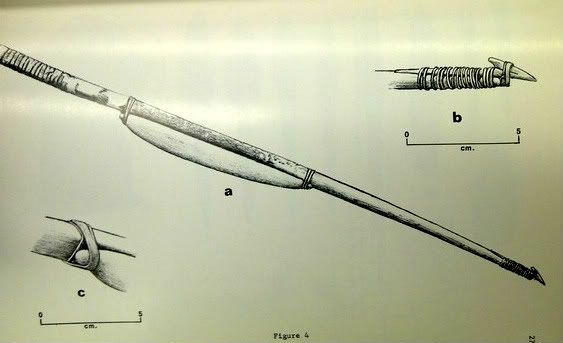
Shown above is a photo of the atlatl.
In 6000 BCE, Indian people, called Archaic by archaeologists, were now occupying the Bonneville Estates Rockshelter. They tended to be more sedentary than the earlier residents of the rockshelter, staying in it for longer periods of time. They were obtaining obsidian for their stone tools from a quarry about five miles from the rockshelter. They brought the obsidian back to the rockshelter and fashioned their tools there. Their diet at this time included Indian rice grass, Great Basin wild rye, pickleweed, and buckwheat. They were also making coiled baskets.
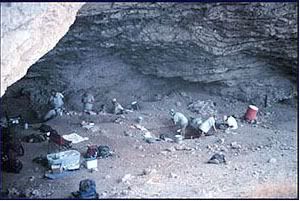
The excavations at Bonneville Estates Rockshelter is shown above.
By 5150 BCE, Indian people were occupying the O’Malley Shelter 16 miles east of present-day Caliente. The people living at the site were involved in the gathering and hunting of locally available plant and animal foods. There was a dependence on large herbivores (deer and bighorn sheep). One of the major activities for the Indian people at the site was the production of stone tools from locally available obsidian and chalcedony.
By 5000 BCE, Indian people were now using the Gatecliff Rockshelter as a campsite.
In 3240 BCE, Indian people living in the Black Rock Desert area were using stone spear points which archaeologists call Scottsbluff.
Around 3000 BCE, Indian people were making stone points known as the Pinto Series. The geographic range of the points is from western Nevada (Hidden Cave site) to Idaho (Weston Canyon Rockshelter). There are five varieties of points: (1) shoulderless; (2) sloping shoulder; (3) square shoulder; (4) barbed shoulder; and (5) one shoulder.
By 2500 BCE, Indian people were occupying Lovelock Cave which was situated near a shallow pond surrounded by tule marshes. The people were collecting fish, shellfish, edible tubers, roots, and seeds. They were using the tule for making baskets. Fiber cordage was used to make snares and nets in which rabbits and birds were caught. Sandals were woven. Blankets were made of bird skins or rabbit fur, and clothing was made of shredded bark. They were also making small split-twig figurines of deer and mountain sheep. Their culture seems to have efficiently used lakeside resources which allowed them to have a sedentary lifestyle.
Indian people in Nevada were weaving sandals and basketry by 2000 BCE. They were also making small split-twig figurines of deer and mountain sheep. In the area of the Lovelock and Humboldt Caves, Indian people were also specializing in using lake resources. They were making nets and fishhooks.
At the Stuart Rockshelter north of present-day Moapa, Indian people were using a type of projectile point called Pinto Series by archaeologists.
Burials:
The study of human remains can provide us with great insights into life in the past. While this is a controversial field, the scientific study of human remains allows the ancestors to talk to us about their lives. Listed below are some of the early burials which have been uncovered in Nevada.
In 7470 BCE, the bodies of a 10 year old child and an adult were wrapped in a diamond-pattern plaited mat and buried in the Grimes Shelter.
In 7414 BCE, the body of a 40-44 year-old man was carefully wrapped in a rabbit skin robe and woven mats and buried in Spirit Cave. One of the woven bags that was buried with him was decorated with interwoven strips of leather and tule stems. Another bag had dark bands of juniper or sage. The skill of these ancient weavers would later astound modern weaving experts: the split reeds and fur so narrow and even, the cord threads so well spun, the weaving itself close, tight, and even, and the variety of techniques and decorations. The textiles found with Spirit Cave Man were woven with a method known as diamond plating; they look essentially like modern woven fabrics.
The diet of Spirit Cave Man had included several different kinds of small fish which indicate that his group used nets or baskets for fishing. The bones in his right hand had been broken and healed. He was buried in a semi-flexed position on his right side with his head oriented toward the northeast.
His moccasins were made out of marmot hide. The moccasins had been crafted in three pieces, stitched together with hemp cordage instead of sinew.
At the time of his death, Spirit Cave Man was in his early forties. He stood about 5’5″ tall. His last meal consisted of water parsnip and small minnows. The man had lived an uncomfortable life because of abnormalities in his spinal column, including the fact that he had 34 vertebra instead of 33. About a year before his death, he had suffered a severe blow to his left temple which had fractured his skull. He had three abscessed teeth which caused the infection that killed him.
The cranial and facial features of Spirit Cave Man are more like those of the Ainu of Northern Japan and some European populations than they are to later American Indian populations. He appears to be different from modern American Indians. He has a long cranium and a long, narrow face suggesting affilinities with Southeast Asian peoples.
In 7290 BCE, a woman died, was wrapped in a mat woven from split tules and native hemp, and was buried in Spirit Cave.
In Nevada, the body of a robust man, 40-45 years old, is buried at Wizards Beach. His teeth are well-worn and the abscess in his lower right molar is the source of the infection that caused his death.
In 7040 BCE, the bodies of two individuals were cremated at Spirit Cave.
Bow and Arrow:
By 500 BCE, the Indian people who were using the Lovelock Cave site had bows and arrows. This more efficient weapon significantly altered hunting styles of the early hunter-gatherers. With the bow and arrow the cultures of the Great Basin change significantly.
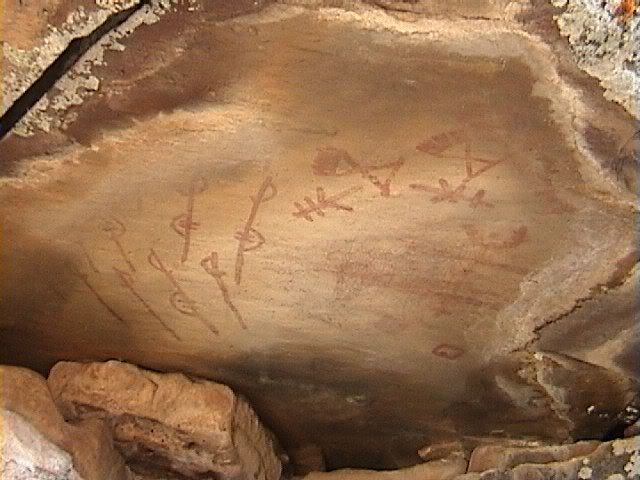
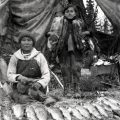
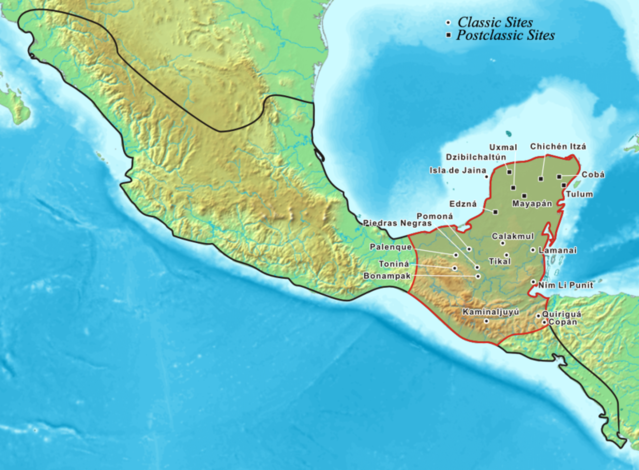
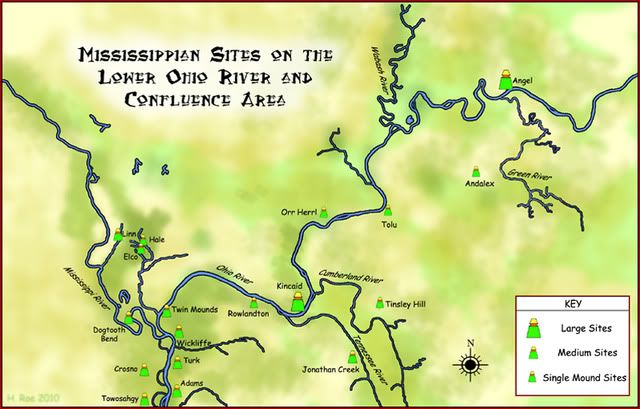
Leave a Reply